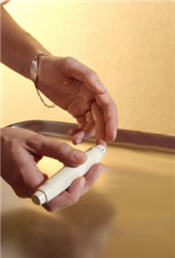by
Barbara Kram, Editor | August 27, 2010

New recommendations
on fingerstick devices
A fingerstick device should never be used for more than one person, FDA and CDC recommended this week.
Fingerstick monitors are in widespread use in health care settings. But the FDA and CDC have come out with recommendations against their use on multiple patients due to difficulty with cleaning and disinfection and links to disease outbreaks.
Fingerstick or blood lancing technology is convenient and fast for gathering capillary samples in settings including primary care and long-term care, among others. But on Thursday, FDA and CDC both issued recommendations that these devices never be used on more than one patient even though sterile lances are used each time.
"Fingerstick and point-of-care (POC) blood testing devices used on more than one patient may not be safe for several reasons. Improper use or device malfunction can lead to the use of the contaminated lancet blade on more than one patient," FDA notes on its website. "It is difficult for healthcare staff to ensure that all blood has been removed from POC blood testing devices and the reusable portions of the fingerstick device. If POC blood testing devices are used on multiple patients and are not cleaned and disinfected correctly and thoroughly between each patient, contaminated blood left on them could result in bloodborne pathogen transmission among patients."
FDA and CDC have noted a progressive increase in bloodborne infection transmission over the past 10 to 15 years (primarily hepatitis B virus or HBV), resulting from the shared use of fingerstick and POC blood testing devices, the agencies report.
Examples of typical patients receiving fingersticks are those with diabetes who require assistance monitoring their blood glucose levels. Reports of HBV infection outbreaks linked to diabetes care have been increasing, CDC reports.
That is one of the reasons fingerstick devices should never be used for more than one person. Whenever possible, POC blood testing devices, such as blood glucose meters and PT/INR anticoagulation meters, should be used only on one patient and not shared. If dedicating POC blood testing devices to a single patient is not possible, the devices should be properly cleaned and disinfected after every use as described in the device labeling, the agencies recommend.
Get the details from
FDA and
CDC.
